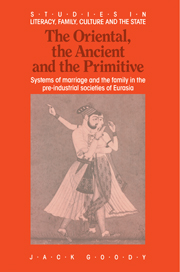 The Oriental, the Ancient and the Primitive
The Oriental, the Ancient and the Primitive Book contents
- Frontmatter
- Contents
- List of illustrations
- List of tables
- Preface
- 1 The nature of the enterprise
- PART I CHINA
- 2 The incorporation of women: marriage transactions and the continuity of the ‘house’
- 3 The lineage and the conjugal fund
- 4 Differentiation, hierarchical and regional
- 5 Land, polyandry and celibacy in Tibet
- PART II INDIA
- PART III THE NEAR EAST
- PART IV GREECE AND ROME, YESTERDAY AND TODAY
- Notes
- References
- Index
4 - Differentiation, hierarchical and regional
Published online by Cambridge University Press: 09 January 2010
- Frontmatter
- Contents
- List of illustrations
- List of tables
- Preface
- 1 The nature of the enterprise
- PART I CHINA
- 2 The incorporation of women: marriage transactions and the continuity of the ‘house’
- 3 The lineage and the conjugal fund
- 4 Differentiation, hierarchical and regional
- 5 Land, polyandry and celibacy in Tibet
- PART II INDIA
- PART III THE NEAR EAST
- PART IV GREECE AND ROME, YESTERDAY AND TODAY
- Notes
- References
- Index
Summary
In this chapter I want to look at the question of marriage and social differentiation principally at the village level, especially as it relates to transactions and strategies. Not only is this essential for understanding China itself, it is just as important for comprehending a whole set of very general differences in marriage, inheritance, kinship and descent between Eurasia and Africa which I have discussed elsewhere (Goody 1971, 1976). For in the latter case economic differentiation at the village level was minimal, at least in terms of land, whereas in the former we are invariably dealing with a kulak situation, that is, with a distinction between richer and poorer peasants. I then look at regional and local variation, pointing to some features that differ markedly in the North and South of China and others that vary within a specific locality. For the latter purpose I use the recent material from Taiwan which has provided a comprehensive set of detailed analyses oriented towards theoretical problems.
Mobility in the village
It would be wrong to think of the Chinese peasant as fixed permanently at a particular point in a system of stratification that depended largely upon his holding of land. In fact there was much mobility up and down. The point is made right at the outset in Hsu's study of West Town where he remarks that from an early age his father's comments made him aware of ‘the rise and fall of families’ (1949:3). He goes on to refer to Yang's account of a North China village where he describes the ‘cycle’ from riches to poverty, based upon the ownership of land.
- Type
- Chapter
- Information
- The Oriental, the Ancient and the PrimitiveSystems of Marriage and the Family in the Pre-Industrial Societies of Eurasia, pp. 93 - 136Publisher: Cambridge University PressPrint publication year: 1990


